One of the things that set Colombia apart from other destinations in South America is its diversity of landscape and wildlife.
From untouched Caribbean coastline to the emerald-green Andean summits, Colombia packs a vast array of flora and fauna spread across 314 different ecosystems and is ranked the second most biodiverse country in the world.
This mega biodiversity is thanks to the country’s unique terrain and climate, influenced by the warm waters of the Caribbean Sea in the north, the elevation changes brought about by the undulating Andes Mountains and its proximity to the equator.
While Colombia certainly could be considered a tropical country in many respects, the temperatures and weather systems can actually vary across the country, with the lower regions experiencing the tropical climate you might expect, while those at higher altitudes, such as Bogotá and Medellin, can feel chillier.
When it comes to choosing the best time to visit Colombia, it’s necessary to consider the conditions in the different parts of the country you plan to visit as well as seasonality.
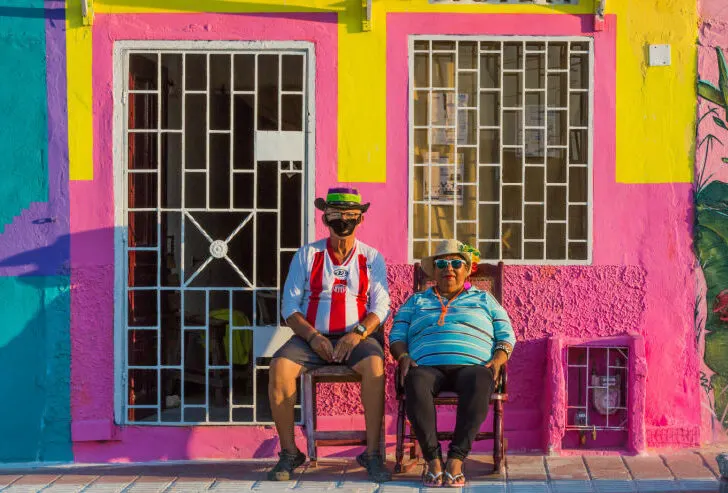
Because average temperatures in most parts remain much the same all year long, the high season for visitors to Colombia is influenced mainly by the Northern Hemisphere’s seasons, with visitors escaping the cold winter back home between December and March.
Want to escape the crowds and have the best chance of the perfect weather for hiking, wildlife spotting, or lounging on a white-sand beach? Read on for our expert advice about the best months to travel to Colombia.
The best months to visit Colombia
- January: Escape the peak season crowds in Cartagena by heading instead to Bogotá, which is deserted as Colombians make a beeline for the coast over the Christmas holidays. Alternatively, take a trip to Eje Cafetero (Coffee Axis) from Medellín to sample some of the country’s finest cups of joe or head out west to the Pacific Coast for wildlife watching and surfing while the weather’s dry.
- February: This month is best for outdoor activities on the Caribbean coast, while the Barranquilla Carnival takes place before Ash Wednesday. For hikers, head out into the national parks across the Andes for sunny, settled weather.
- March: As the dry weather along the Caribbean coast continues, go trekking in Sierra Nevada mountains to reach the UNESCO World Heritage archaeological site, Ciudad Perdida, one of the best places to visit in Colombia. Alternatively, spend time exploring the capital, Bogotá while the weather’s warm.
- April: Celebrate Semana Santa with the locals in the country’s largest celebrations, which are held in Popayán, in southern Colombia. Alternatively, maximise your time beach bumming in Cartagena de Indias during shoulder season before the rainy season begins or head over to the gorgeous Caribbean islands of San Andrés and Providencia.
- May: The wettest month in Colombia is the best time to avoid crowds – although you’ll definitely need a raincoat. Avoid the Amazon region and instead head to Calí for salsa dancing.
- June: As the rain slows, but the rivers are still easily accessed by boats, head deep into the Amazon jungles to spot parakeets, toucans, and pink river dolphins.
- July: Take advantage of the “dry” period in Antioquía to visit Jardín, Colombia’s most atmospheric colonial town or spend a few days kicking back in Medellin, the “City of Eternal Spring”.
- August: Join the paisas (residents of the Antioquia department) to celebrate Feria de Las Flores for ten consecutive days in August.
- September: Visit parks in the Amazon region, such as Amacayacu National Park; during this drier month, you can hike and trek through the rainforest rather than explore by boat.
- October: The wettest month in most parts of Colombia, October is the time to explore indoor activities in the capital city. Discover Bogotá through its museums, galleries, and glut of excellent restaurants.
- November: While much of the rest of the country is at the mercy of the weather, the La Guajira peninsula in the northeast of Colombia is still hot and dry – and its remote location makes it a great place to avoid the crowd regardless of the season.
- December: Soak up the sun on the beaches of Cartagena, Barranquilla, and Tayrona National Park (Parque Nacional Natural Tayrona). Alternatively, hit up Medellin for sunny weather or head to Calí to celebrate one of the biggest festivals in Colombia, the Feria de Calí.
The best weather conditions by region
Located in the northwest corner of South America, Colombia is bordered by the Caribbean Sea to the north and the Pacific Ocean to the west. As a result, the climate varies significantly by its natural regions: the Caribbean, Pacific, Amazon, Orinoquia, and Andean Regions.
Colombia generally has a temperate and tropical climate, where more than 80% of its area is considered hot due to its proximity to the equator. However, each natural region has its own conditions.
The Amazon: Leticia, Puerto Nariño and Putumayo
The Amazon region of Colombia is hot and humid year-round, with an average temperature of 27°C (81°F).
The rainy season falls from December through May, with the heaviest rainfall occurring in April and May; this season sees most of the forest submerged by growing rivers, which gives you more chance to spot birds, monkeys, and other animals that spend their time in the treetops.
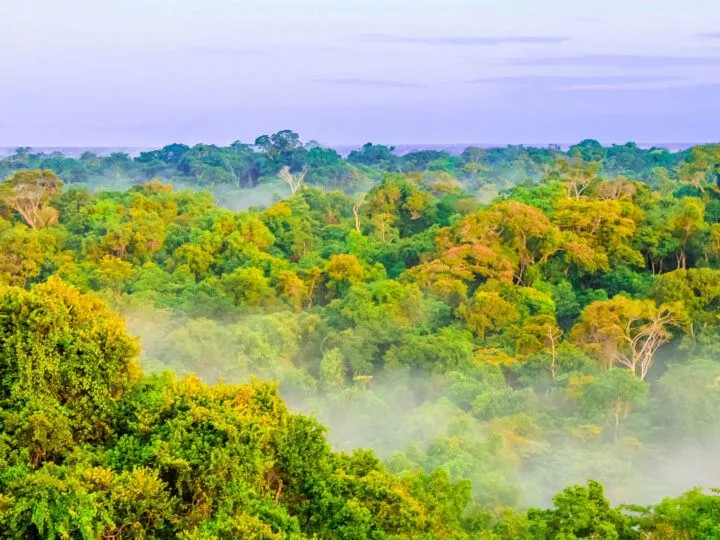
Between the dry months of June and September, conditions are better for hiking forest trails and spotting terrestrial animals.
The best time to explore the Amazon: June through September
Despite the hot and humid conditions, the Amazon Rainforest can still be explored between June and September.
With the help of binoculars and a guide, patient observers can spot parakeets, cormorants, and toucans in the foliage. Moreover, you may get to see the pink river dolphins that live in Amazonian waters.
Even though June to September is technically the dry season, there’s still around a 50% probability of precipitation. So it’s best to wear light, breathable clothing and pack a raincoat just in case.
It’s also advisable to bring insect repellent to protect against mosquitoes and insects; mosquito-proof clothing will also be a godsend.
The Caribbean Coast: Cartagena, Barranquilla, Santa Marta and Tayrona National Natural Park
Not only does Colombia’s Caribbean coast have dazzling beaches, but its warm tropical climate promises year-round sunshine.
The average temperature ranges from 25°C (77°F) to 32°C (89.6°F), and the closer you are to the coast, the hotter it feels and the higher the humidity.
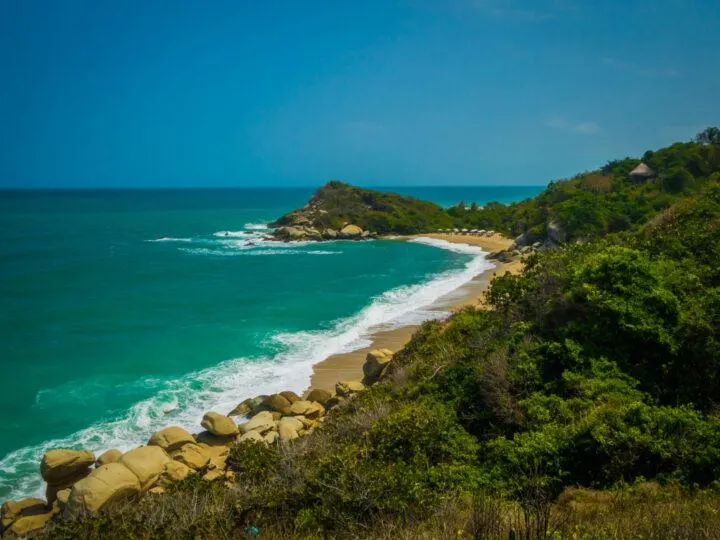
The rainy season typically runs from May to November, with heavy downpours in the afternoons and evenings. But don’t let this deter you.
Rain usually only lasts a few hours, often bringing a welcome break from the heat. Just be sure to bring a rain jacket or umbrella to stay dry when sightseeing and hiking.
However, if you plan on snorkeling, diving, surfing, and exploring the beaches, it’s best to visit during the dry season from December to March.
The best time to explore the Caribbean Coast: December through March
During these months, you can expect blazing sunshine and few – if any – rainy days. Although temperature-wise, there’s no significant difference between the dry and wet seasons along this stretch of Colombia, in January and February, you may not see rain at all.
As a result, these months are perfect for lounging on the beach, getting under the skin of Cartagena, or taking a day tour out to one of the islands surrounding the city.
Bear in mind that this is the high season for travel and the beaches along the Caribbean Coast are guaranteed to be packed with both local and foreign tourists, while the best hotels in Cartagena are likely to be fully booked.
For quieter beaches and fewer visitors in the region’s landmark national park, Parque Nacional Natural Tayrona, consider the shoulder seasons of November and March, particularly as the park closes for the first half of February.
The Andes: Medellín, Manizales, Bogotá, Bucaramanga and Calí
The Colombian Andes is one of the most diverse mountainous regions in the world when it comes to climate.
The average temperature is around 18°C (64°F), but it’s highly influenced by altitude and latitude and the region is divided into three branches (cordilleras) as a result of these two factors.

The Cordillera Occidental, which is adjacent to the Pacific coast, is the lowest of the three. This branch includes Calí, where average temperatures hover around 24°C (75.2°F) year-round, and where two rainy periods – March through May and October through November – are experienced.
The locals refer to the other months as the “dry” season, however, rain may fall on any day, so it’s best to pack waterproof clothing or an umbrella.
The Cordillera Oriental, the second highest branch and the widest include Bucaramanga and Bogotá. The capital city sits at 2,640 meters (8,660 ft) above sea level, which makes its weather different from most cities in this branch.
Sunny days are rare, as fog fills the air every morning and is replaced with clouds in the afternoon. As a result, it can be quite cold in Bogotá, with an average temperature of just 14°C (57.2°F) and temperatures dropping to as low as 0°C (32°F) at night.
Expect rain – or at least drizzle – throughout the year, although December and January are often drier.
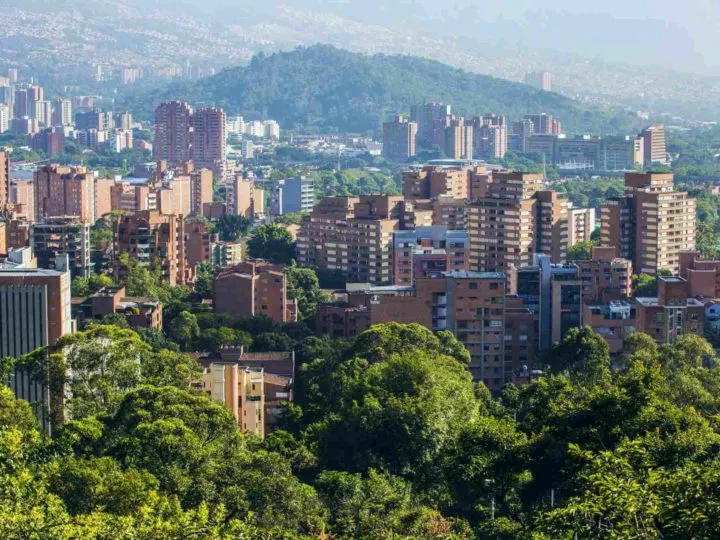
The Cordillera Central is the highest branch, with Nevado del Huila its loftiest peak at 5,364 metres (17,598 ft) and includes Manizales and Medellín. The latter sits at 1,500 metres (4,900 ft) with an average annual temperature of 22°C (72°F), which is the reason behind its nickname the “City of the Eternal Spring”.
This branch has more rainy days than the other two: on average, 19 days per month, with the most rainfall between April and May and September through November.
The best time to visit the Andes: December through January
In general, the Andean region is a year-round destination. But if you want to avoid the rain, aim for December and January, when Colombians flock to the coast. Though the days are not entirely rain-free, these months are the “driest” in this part of Colombia.
In Calí and most of the Cordillera Occidental, these months are the “summer” and temperatures can hit 34°C (93.2°F) during the day and drop to 15°C (59°F) at night.
Bogotá, and most other cities in the Cordillera Oriental, enjoy more sunshine hours during these months. Medellín, in the Cordillera Central, maintains its pleasantly warm climate with less rain than other times during the year.
The Pacific Coast
With its warm, tropical climate and diverse weather patterns, the Pacific region is one of the wettest places in the world.
As it rains almost constantly here, this region is popular for its surfing and ample wildlife, with the ocean packed full of humpback whales between July and October, and hawksbill turtles laying eggs at Bahía Solano from September through December.
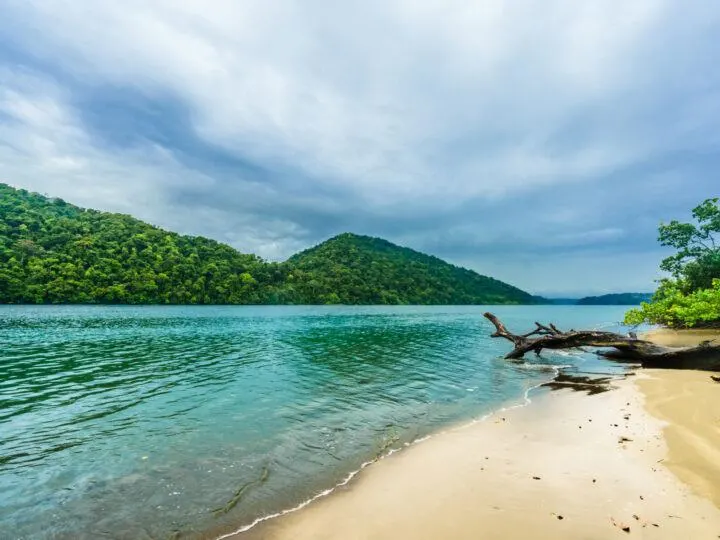
Like most areas in Colombia, the Pacific region has its driest days in December through January, while the temperature stays pretty constantly between 25°C (77°F) and 32°C (90°F) throughout the year.
Los Llanos Orientales
While avoiding the wet season in the Pacific region is advisable, it is a must in the Los Llanos Orientales region, a stretch of savannah that belongs to the Orinoco River watershed and which floods during the rainy season. Throughout the years, temperatures mostly remain stable between 22°C (72°F) and 33°C (92°F).
Known for its remarkable diversity of wildlife (it’s home to over 100 species of mammals and 700 species of birds), the eastern plains become an even great refuge for birdlife during the rainy season.
Between May and September, large parts of these grasslands convert into wetlands, attracting migrating water birds and making them the perfect place for kayaking.
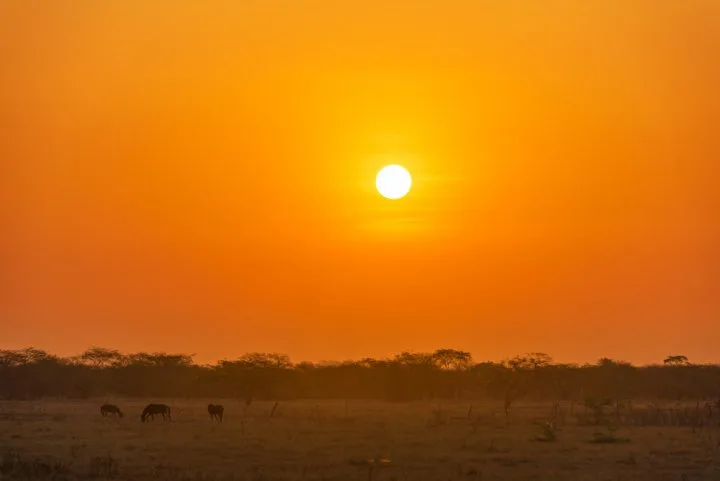
For a better chance of spotting wildlife such as capybaras and monkeys, visit between November and April when the waters recede, which is also a brilliant chance to learn about the region’s cowboy culture.
From July to November is also the best time to see the curious pink algae bloom in the Caño Cristales, a river tucked into Serranía de La Macarena National Park in the southwest of the region.
The best time to avoid crowds in Colombia
Since most visitors come to Colombia to avoid winter in the Northern Hemisphere, the peak season for travel in Colombia is usually between December and March, when the weather is at its driest, and when city-dwellers head to the Caribbean Coast to soak up the summer’s sunshine.
June through August is also often crowded with local tourists when students are out of school for their summer vacation.
During these months, expect more tourists, longer lines at popular attractions, and higher prices for accommodations and activities.
In the shoulder seasons, you’ll also experience tourism peaks during special events and festivals. With that said, if you don’t mind crowds and are looking to experience unique and authentic interactions with local people and Colombian culture, this can be a great time of year to visit.
The most famous festivals in Colombia
January (2nd to 9th of January): Blacks and Whites Carnival
- This six-day carnival celebrates Afro-Colombian and indigenous cultures and the concept of unity. It is known for its colourful and vibrant parades, which feature traditional music, dance, and costumes.
February (before Ash Wednesday): Barranquilla Carnival
- One of the largest carnivals in the world, Barranquilla Carnival celebrates the upcoming fasting season of Lent. Eat, drink, and dance with the locals for four days straight to live up to the festival’s slogan: “Quien lo vive, es quien lo goza!” – those who live are those who enjoy!
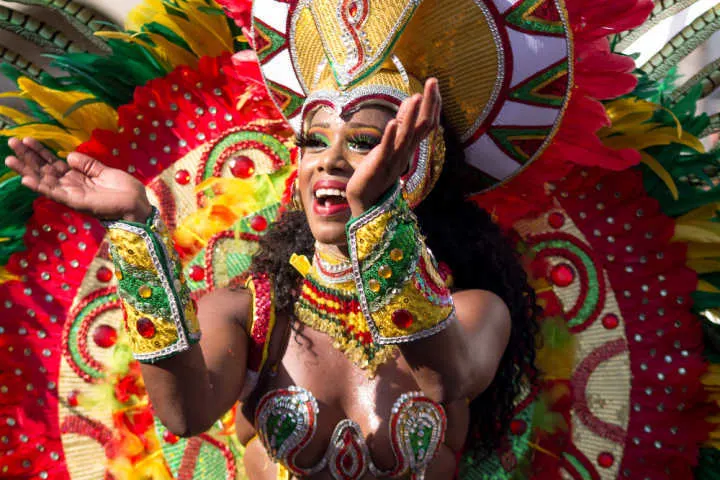
April (one week before Easter): Semana Santa
- For one week, the whole country celebrates its second most important religious holiday: Easter. Each city has its own unique traditions, but the one that attracts the most is Popayán, a town in the southwest of Colombia. Added in 2009 to UNESCO’s list of Intangible Cultural Heritage of Humanity, Popayán’s Holy Week processions involve a two-kilometer parade of flower-decked statues and floats.
August (first week): Feria de las Flores
- The Feria de las Flores is a 10-day annual event held in Medellín that celebrates the city’s rich flower-growing tradition. The main event during the festival is the Desfile de Silleteros, which features people dressed in traditional attire carrying large baskets of flowers on their backs.
December (last week of the month): Feria de Calí
- An event celebrating the city’s cultural identity, the Feria de Calí lasts for five days and includes a Salsa marathon, dance parties and parades, and a variety of food and craft stalls across the city where you can sample traditional Colombian cuisine and purchase locally made products.
Tips for attending festivals in Colombia
- Book accommodation close to the festival location. This will give you easy access to events and avoid spending too much time stuck in traffic in Colombia’s infamously congested cities.
- Pack light. A small backpack or crossbody bag with essentials like water, sunscreen, and a power bank is sufficient.
- Wear comfortable clothes and shoes. Festivals can be long and involve a lot of standing or dancing. Avoid wearing anything too heavy or constricting, and consider bringing a hat or sunglasses to protect yourself from the sun.
- Stay hydrated, especially when it’s hot and humid.
- Bring cash. Most food and drink vendors and stalls only take cash.
- Protect your belongings. Keep your valuables close to you, and consider using a wrist wallet or money belt to keep your cash and cards safe.
Conclusion: the best time to visit Colombia
To avoid crowds while enjoying lower prices, we recommend visiting Colombia during the low season, which is between April and May or September and October.
The catch is these months are usually the wettest in most areas; so if you want to explore Colombia’s incredible national parks, you’ve got little choice than to visit during the dry months (December through March and July and August).
If you plan on visiting more than one region, you’ll find our one- and two-week Colombia itinerary an essential guide for your trip.
